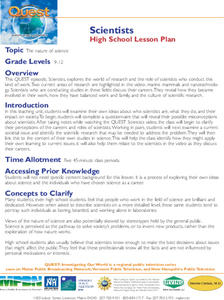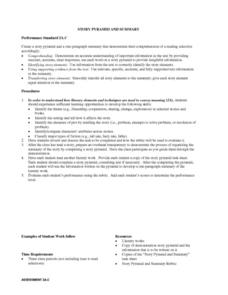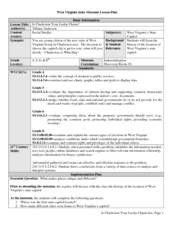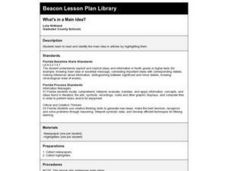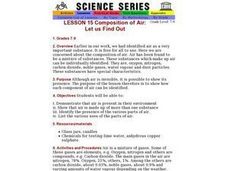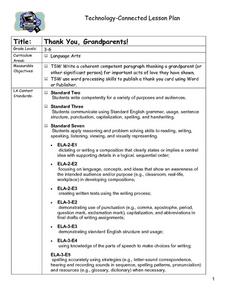Curated OER
Hunger/ Nutrition
Seventh graders investigate nutrients and nutrition to determine what types of food the body needs for energy. They study each type of nutrient and why it is important to the body. They determine what a balanced diet is by completing the...
Curated OER
What's Mongolia Really Like?
Students look at rural Mongolian nomadic culture through the eyes of a Peace Corps Volunteer and examine the dynamics of a people in transition. They give one important reason for migration from a rural to an urban setting and explain...
Curated OER
Remembering WWII Through Memorials
Learners create memorials for lesser known WWII heroes. In this WWII lesson, students recognize the efforts of lesser know individuals and groups that contributed to the wartime cause. Learners work in groups to create a memorial for one...
Curated OER
Qur'an: Sacred Scripture of Islam
Students discover the strong emphasis Islam puts on education. Using the Internet, they identify advancements in ethics, math and astronomy. They explain the importance of madrasahs, or traditional places of learning in Islam, and...
Curated OER
Limits of Power
Students examine the importance of limiting power in governments. In this government instructional activity, students investigate the importance of placing limits on government by looking at the US Constitution. They look at ways that...
Curated OER
Halloween Literature Unit: Arthur’s Halloween
Students read the story "Arthur's Halloween" and discuss how they have helped someone. In this "Arthur's Halloween lesson plan, students play a game that strengthens their listening skills. Students participate in identifying...
Alabama Learning Exchange
Dancing to New Heights
Pupils identify proper body alignment through experiencing proper sitting, standing or prone positions. They identify and demonstrate different types of movements.
Curated OER
Scientists
Students explore the role scientists play in research. They research current important areas of scientific interest. They write about how this issue could affect them. They create posters about their chosen scientific issues.
Curated OER
Story Pyramid and Summary
Young scholars read a short selection of a story individually or as a class. On their own, they create a story pyramid for the selection and write a one page summary. They use text from the story for their supporting details. To end...
Curated OER
Clothing Color Wheel
Students are introduced to the primary, secondary and tertiary colors. Individually, they are to create a color wheel with all three levels of colors in a creative way. To end the lesson, they present their wheel to the class and...
Curated OER
Community Explorations
Learners identify the strengths and weakness in their community. They take a community walk and take pictures of people interacting with the environment and the "green spaces" in their community. They then write a persuasive essay...
Curated OER
Is Charleston Your Lucky Charm?
Students determine what makes Charleston, West Virginia unique. In this West Virginia history lesson, students explore the West Virginia History Museum to identify why Charleston became the capitol of the state.
Curated OER
An Irresistable Offer?
Young scholars identify inducements the emperor Constantine offered people to move to his fledgling capital city of Constantinople and compare similar situations offered by the American government in our history and by local governments...
Curated OER
It's a Wrap!
Students read about the importance of packaging foods and related items properly and reducing waste. In this packaging lesson, students read the background information about packaging and bring a variety of packaging materials to class....
Curated OER
What's in a Main Idea?
Second graders read newspaper articles. In this language arts lesson, 2nd graders identify the main ideas found in the articles by highlighting them. The entire class selects one interesting article from the sports section to discuss.
Curated OER
Composition of Air: Let us Find Out
Students identify the various components of air as they demonstrate that air is present in the environment.
Curated OER
RIGHT TO EQUAL OPPORTUNITY
Students learn the importance of fairness and come up with strategies to create this type of environment in their classroom.
Curated OER
You Can Change the World
Students discuss ways they can help protect the environment. In groups, they examine various types of animals and identify their characteristics, food and habitats are compared. They create a Hyperstudio presentation in which they scan...
Curated OER
Thank You, Grandparents!
Students share important moments with their grandparents. Individually, they write one paragraph thanking them for being in their lives or for a specific event they have been involved in. They also identify ways they act like their...
Curated OER
Where Have All the Endangered Gone?
Students explore animals that are endangered. They choose an endangered animal that they would like to keep from becoming extinct. Students create a persuasive presentation to persuade someone to understand why they feel keeping their...
Curated OER
Swimmy Swim Swiftly
Students examine the letter 's'. Through instruction and modeling they explore the sound the letter makes, how the letter is written, words that contain the letter, etc. They listen to a story and identify words with the /s/ sound by...
Curated OER
Why do we need a Government
Students explore some of the ideas of major importance to the Founders, why we need a government, and how the Founders believed governments should be created and what they should do. They think of a right that all people should have and...
Curated OER
Finding Your Way Using Maps and Globes
Students identify the similarities and differences between different maps and globes. Individually, they create a map of their classroom along with a compass rose. They also practice reading maps as a class and finding specific locations.
Curated OER
Wacky Water Critters
Students visit a local creek or stream. They collect water samples from the creek and observe and sort the "water critters" they find in the sample, observing smaller organisms under a microscope if necessary. They identify each organism...







